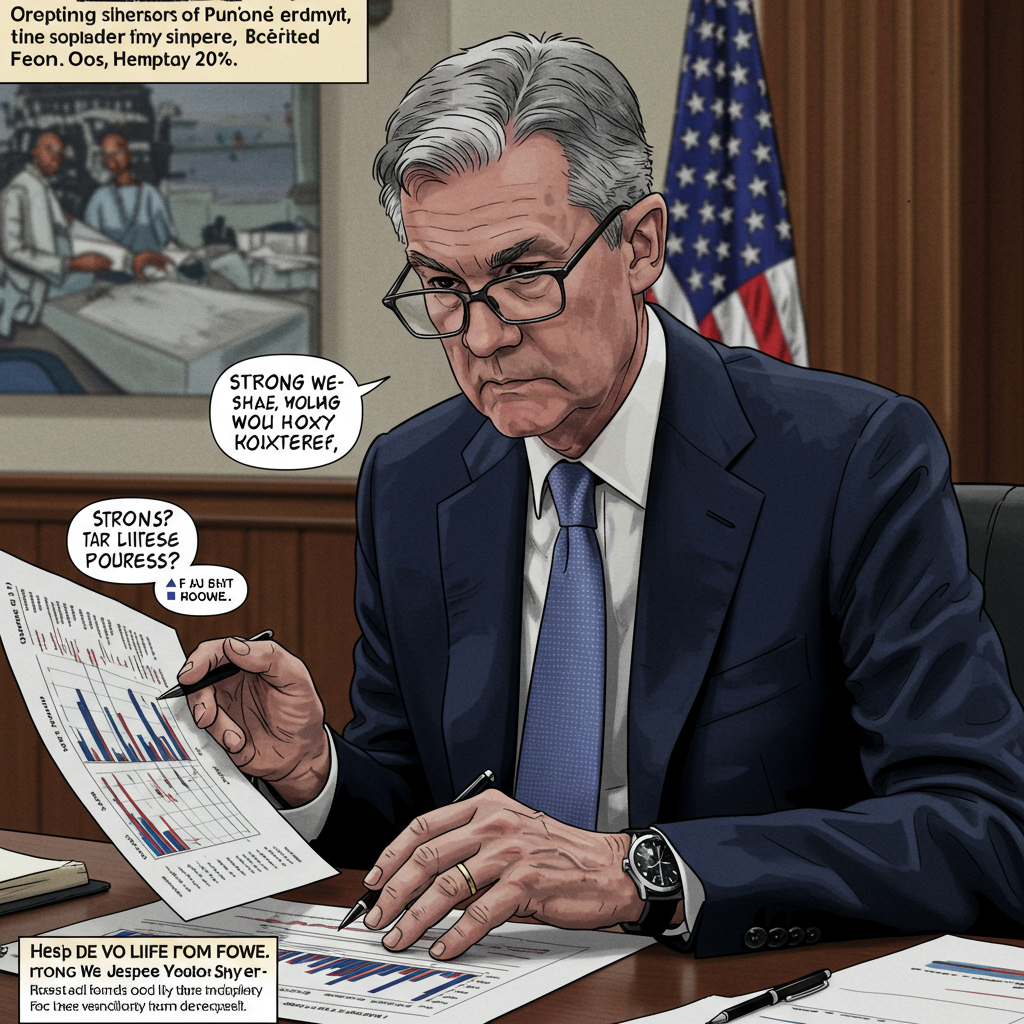A surprisingly robust jobs report has dramatically shifted expectations for when the federal Reserve might finally cut interest rates. Far from showing signs of cooling, the latest U.S. labor market data revealed unexpected strength, giving the central bank little immediate reason to ease monetary policy. This development comes as a disappointment to many hoping for lower borrowing costs soon, pushing the likely timeline for rate relief further into the future.
Market analysts quickly reacted, with probabilities for a near-term interest rate cut plummeting immediately following the release of the latest figures. The focus has now squarely moved away from earlier meetings, with many experts and investors now pointing towards a later date in 2025 for the first potential move by the Fed.
The Latest Jobs Report Shockwave
The U.S. labor market continues to defy predictions of a slowdown. The most recent report revealed a net increase of 256,000 non-farm payrolls in December, significantly accelerating from the upwardly revised gain of 212,000 in November. This strong performance blew past many economists’ forecasts.
Adding to the picture of a resilient job market, the unemployment rate saw a modest dip from 4.2% to 4.1%. This drop occurred even as more individuals entered the workforce, highlighted by a substantial rise in employed individuals (+478,000) according to the household survey. Total U.S. payrolls reached a new record high, now exceeding 159.5 million jobs. These figures paint a clear picture: the job market remains solid.
Deeper Dive into Labor Strength Signals
Beyond the headline numbers, other data points reinforce the labor market’s resilience. Initial jobless claims remain notably low, hovering around 201,000. Continuing jobless claims are also at historically low levels, representing only about 1.1% of the labor force.
Furthermore, recent JOLTS data showed 8.1 million job openings. While down from peak pandemic levels, this number is still higher than any pre-pandemic record. This indicates a significant surplus of available jobs compared to the number of unemployed individuals (approximately 6.2 million). Such conditions suggest that large, multi-month net payroll losses are highly unlikely in the near future, further strengthening the argument against an urgent need for the Fed to stimulate the economy through rate cuts.
Why Strong Jobs Data Delays Rate Cuts
The Federal Reserve operates under a dual mandate from Congress: promoting maximum employment and stable prices (controlling inflation). When the labor market is exceptionally strong, as current data suggests, one half of that mandate is clearly being met.
This strength in employment gives the Fed more flexibility to focus on the other half of its mandate: controlling inflation. Despite some progress, consumer price inflation remains persistently above the Fed’s 2% target. As of November 2024, year-on-year consumer inflation rates stood at 2.7% for Total CPI and 3.3% for Core CPI (excluding volatile food and energy). PCE inflation, the Fed’s preferred gauge, was 2.4% total and 2.8% core.
Inflation’s Stubborn Presence
While total CPI and PCE rates might edge closer to the 2% target in 2025, particularly due to base effects from previous year’s price changes, core inflation measures are proving more stubborn. Experts suggest core rates could potentially remain above the 2% target for most or all of 2025.
The combination of a solid, resilient labor market and elevated, potentially sticky inflation rates presents a strong case for the Federal Reserve to maintain its current elevated interest rate levels. There is simply less urgency to cut rates when employment is robust and inflation risks persist. The Fed has room to remain in a “wait and see” mode.
Market Reaction: Hopes Dashed, Yields Climb
Financial markets responded swiftly to the surprisingly strong jobs report. The perceived probability of the Fed implementing a 25-basis-point rate cut at its upcoming meeting on January 29, 2025, which was already low at 6.9% before the report, plummeted further to just 2.7% according to the CME FedWatch Tool. Such a low probability is often considered statistically zero by traders.
This shift in expectations had a clear impact across asset classes. Stock markets saw a slight uptick as traders initially reacted positively to the strong underlying economic data, but the diminished prospects of swift rate cuts limited more substantial gains.
The bond market exhibited a more pronounced reaction. Yields rose significantly, reflecting the market’s expectation that the Fed will need to keep rates higher for a longer period. The yield on the benchmark 10-year US Treasury bond increased by 4 basis points to approximately 4.34%, while the yield on the 2-year Treasury, which is particularly sensitive to changes in Fed policy expectations, spiked by 9 basis points to 3.88%. Rising bond yields generally indicate investor belief in sustained economic strength and higher future interest rates.
The Shifting Timeline for Rate Relief
With a January rate cut now seen as virtually off the table, the focus has shifted to subsequent Federal Open Market Committee (FOMC) meetings. Earlier hopes for a summer rate cut have now largely faded, replaced by expectations for a later timeline.
Based on the strong December data and persistent inflation concerns, many analysts and market participants now anticipate that the next 0.25% interest rate cut by the Fed may not occur until May 2025. This expectation is partly based on the projection that year-on-year total CPI and PCE inflation rates might ease more noticeably in the second quarter of 2025.
The latest December 2024 FOMC projections themselves only reflect expectations for two 0.25% cuts over the entirety of 2025. Some economists even suggest that the risk of acceleration in upcoming inflation reports could potentially reduce the expected number of cuts to just one for the entire year. For borrowers and businesses hoping for significant relief on interest expenses, the path forward looks slower than previously hoped.
Political Crosscurrents for the Fed
The Federal Reserve’s decisions on interest rates often operate amidst political scrutiny. Strong economic data that prevents rate cuts can sometimes intensify this pressure, particularly from those who advocate for lower rates to stimulate growth, borrowing, and specific sectors like housing.
While the strong jobs data makes a near-term rate cut less likely based on economic fundamentals, it also occurs during periods where the Fed Chair, Jerome Powell, faces public criticism for maintaining elevated rates. Some political figures have openly criticized Powell for not cutting rates sooner, suggesting it harms the economy and the housing market, where 30-year fixed mortgage rates have hovered around 6.77%.
Despite this pressure, economic analysts generally expect Powell to maintain his stance. The consensus view is that the Fed is determined to fulfill its mandate based on economic data, insulated from political influence. Some observers even speculate that blunt criticism might have the unintended effect of making the Fed leadership less inclined to appear swayed, further prioritizing its independence and data-driven approach.
Navigating Higher Rates: Implications
For average Americans and businesses, the implication of this revised timeline is that borrowing costs are likely to remain elevated for longer than previously anticipated. This affects everything from mortgage rates and auto loans to business lines of credit.
While a strong labor market is broadly positive for the economy and individual financial security, the delay in rate cuts means the financial environment characterized by higher interest rates will persist. Planning for major purchases, financing, and investment decisions should take this updated outlook into account. The focus remains on future economic data, particularly upcoming inflation reports, to see if the landscape shifts again.
Frequently Asked Questions
What specific jobs data led the Fed to likely delay interest rate cuts?
The key data point was the December 2024 non-farm payrolls report, which showed a strong net increase of 256,000 jobs, significantly exceeding expectations. Additionally, the unemployment rate dipped to 4.1%, and total payrolls reached a record high. This resilience in the labor market gives the Federal Reserve less incentive to cut rates quickly, as strong employment is one half of its mandate.
When do experts now predict the Federal Reserve might cut interest rates?
Following the strong jobs report and persistent inflation concerns, the consensus expectation for the Federal Reserve’s first interest rate cut has shifted. While some previously hoped for cuts early in the year, many analysts and market participants now anticipate the initial 0.25% rate reduction may not occur until May 2025. Some forecasts even suggest only one or two cuts may happen throughout all of 2025.
How does the strong jobs report impact borrowers and the housing market?
A strong jobs report that delays Fed rate cuts typically leads to higher bond yields, including those influencing mortgage rates. With the Fed expected to keep its benchmark rate higher for longer, borrowing costs for consumers and businesses, such as mortgage rates, auto loans, and credit lines, are likely to remain elevated as well. This scenario presents challenges for the housing market by impacting affordability for potential buyers.
Conclusion
The latest jobs report serves as a clear signal that the U.S. labor market remains unexpectedly robust. This strength, combined with inflation that is still above the Federal Reserve’s target, provides a strong justification for the central bank to delay anticipated interest rate cuts. While this is positive news for overall economic stability and employment, it means borrowers and markets should prepare for a financial environment where interest rates remain higher for a longer period, potentially pushing the first rate cut into the second quarter of 2025. All eyes will now be on future economic data, particularly inflation figures, for clues about the Federal Reserve’s next moves.



